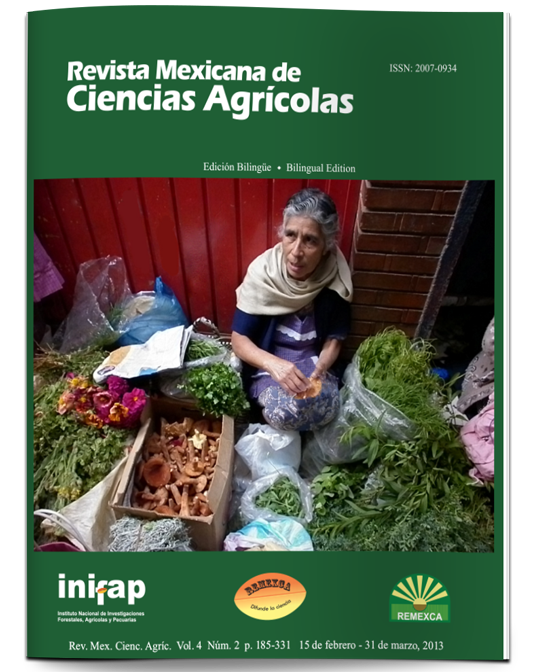Arbuscular mycorrhiza in sorghum under different agro-technological and environmental management
DOI:
https://doi.org/10.29312/remexca.v4i2.1233Keywords:
Sorghum bicolor, Glomus intraradices, productivityAbstract
The symbiotic relationship between arbuscular mycorrhizal fungi (AMF) and plants induce to improve nutrition and plant health. The biotechnological application of AMF in production systems will depend on the effectiveness of the strain on the agro ecological environment, as well as its adoption with existing practices and equipment. It was determined the effectiveness of Glomus intraradices (strain from INIFAP) inoculated the seed of sorghum (Sorghum bicolor) under different agricultural and environmental management in Tamaulipas during 2007- 2009. 21commercial plots were established, 13 under rainfed and eight under irrigation (0.25-1ha), where the seed was compared with and without the inoculant G. intraradices, the agronomical management was used by the producers. Under rainfed weren’t added inorganic fertilizers, while under irrigation was used in different doses of N and P, only in one site manure was incorporated (2 t ha-1). Measurements made were, length of panicle, radical fresh biomass and grain yield. The cost of production was estimated (cost-benefit) at each site. On average under rainfed and irrigation was found that G. intraradices increased (p≤ 0.01) root biomass, panicle length and grain yield of 7.6 g, 3.3 cm and 524 kg ha-1, respectively and the profitability of production grew 17%. The results proved a consistent promoting response that the mycorrhizal inoculant had on sorghum, compared with non-inoculated seed, despite the variability of genotypes, soils, agronomical and environmental practices.
Downloads
Downloads
Published
How to Cite
Issue
Section
License
The authors who publish in Revista Mexicana de Ciencias Agrícolas accept the following conditions:
In accordance with copyright laws, Revista Mexicana de Ciencias Agrícolas recognizes and respects the authors’ moral right and ownership of property rights which will be transferred to the journal for dissemination in open access. Invariably, all the authors have to sign a letter of transfer of property rights and of originality of the article to Instituto Nacional de Investigaciones Forestales, Agrícolas y Pecuarias (INIFAP) [National Institute of Forestry, Agricultural and Livestock Research]. The author(s) must pay a fee for the reception of articles before proceeding to editorial review.
All the texts published by Revista Mexicana de Ciencias Agrícolas —with no exception— are distributed under a Creative Commons License Attribution-NonCommercial 4.0 International (CC BY-NC 4.0), which allows third parties to use the publication as long as the work’s authorship and its first publication in this journal are mentioned.
The author(s) can enter into independent and additional contractual agreements for the nonexclusive distribution of the version of the article published in Revista Mexicana de Ciencias Agrícolas (for example include it into an institutional repository or publish it in a book) as long as it is clearly and explicitly indicated that the work was published for the first time in Revista Mexicana de Ciencias Agrícolas.
For all the above, the authors shall send the Letter-transfer of Property Rights for the first publication duly filled in and signed by the author(s). This form must be sent as a PDF file to: revista_atm@yahoo.com.mx; cienciasagricola@inifap.gob.mx; remexca2017@gmail.
This work is licensed under a Creative Commons Attribution-Noncommercial 4.0 International license.



